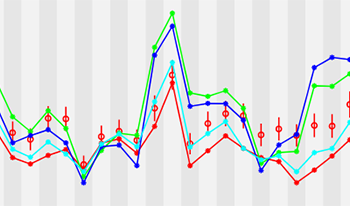
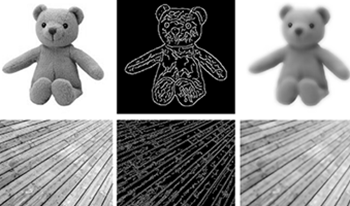
The perceptual process of images is hierarchical. Human tends to first perceive global structural information such as shapes of objects and further focus on local regional details such as texture. Furthermore, it is widely believed that structure information plays the most important role in task of utility assessment and quality assessment, especially in new scenarios like free-viewpoint television, where the synthesized views contain geometric distortion around objects. We thus hypothesize that the degradation of structural information in an image is more annoying for human observers than the one of the textures in certain application scenarios. In order to confirm our hypothesis, a bilateral filtering based model (BF-M) is proposed referring to a recent subjective perceptual test. In the proposed model, bilateral filters are first utilized to separate structure from the texture information in images. Afterward, features that capture object properties and features that reflect texture information were extracted from the response and the residual of bilateral filtering separately. A contour, a shape related and a texture based estimator are then proposed with the corresponding extracted features. Finally, the model is designed by leveraging the three estimators according to target tasks. With the task-based model, one can then investigate the role of structure/texture information in certain task by checking the correspondence optimized weights assigned to the estimators. In this paper, the hypothesis and the performance of the BF-M is verified on CU-Nantes database as utility estimator and on SynTEX, IRCCyN/IVC-DIBR databases as quality estimator. Experimental results show that (1) structure information does play greater role in several tasks; (2) the performance of the BF-M is comparable to the state-of-the art utility metrics as well as the quality metrics designed for texture synthesis and views synthesis. It is thus validated that the proposed model can also be applied as a task-based parametric image metric.

The authors present a framework for image-based surface appearance editing for light-field data. Their framework improves over the state of the art without the need for a full “inverse rendering,” so that full geometrical data, or presence of highly specular or reflective surfaces are not required. It is robust to noisy or missing data, and handles many types of camera array setup ranging from a dense light field to a wide-baseline stereo-image pair. They start by extracting intrinsic layers from the light-field image set maintaining consistency between views. It is followed by decomposing each layer separately into frequency bands, and applying a wide range of “band-sifting” operations. The above approach enables a rich variety of perceptually plausible surface finishing and materials, achieving novel effects like translucency. Their GPU-based implementation allow interactive editing of an arbitrary light-field view, which can then be consistently propagated to the rest of the views. The authors provide extensive evaluation of our framework on various datasets and against state-of-the-art solutions.
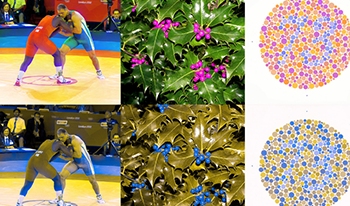
We propose a daltonization method that enhances chromatic edges and contrast for color-deficient people by optimizing the gradient of an image. We rotate and scale the error gradient between the original and its simulation in the color space into the direction of optimal visibility that is orthogonal to both the main direction of information loss and the direction of lightness. Then, we reintegrate the daltonized image version from the modified gradient through an iterative diffusion process. Moreover, we include multiscaling to guarantee optimal daltonization on different scales of the image. Also, we provide an interface for data attachment modules designed to maintain naturalness of memory colors like neutral colors. We evaluate and compare our proposed method to other top-performing daltonization methods in behavioral and psychometric experiments. A visual-search experiment assessing performance of the attentional mechanism of the human visual system before and after daltonization measures the greatest improvement in accuracy for our proposed method compared to the original and all investigated daltonization methods. It also reveals optimal results for both natural and Ishihara images among both protan and deutan color-deficient observers. Furthermore, we can deduce from the results of a pairwise preference evaluation that our proposed method is preferred highest amongst all color-deficient people in total. Our proposed method is also ranked among the most preferred daltonization methods for both protan and deutan color-deficient observers individually.
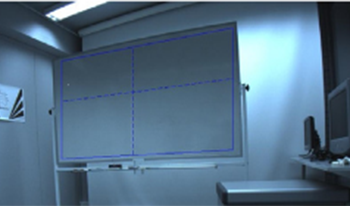
Whiteboards are commonly used as a medium of instant illustration of ideas during several activities including presentations, lectures, meetings, and related others through videoconferencing systems. However, the acquisition of whiteboard contents is inhibited by issues inherent to the camera technologies, the whiteboard glossy surfaces along with other environmental issues such as room lighting or camera positioning. The contents of whiteboards are mostly invisible due to the low luminance contrast and other related color degradation problems. This article presents an account of a work aimed at extracting the whiteboard image and consequently enhancing its perceptual quality and legibility. Two different methods based on color balancing and color warping are introduced to improve the global and local luminance contrast as well as color saturation of the contents. The methods are implemented based on different general models of the videoconferencing environment for avoiding color shifts and unnaturalness of results. Our evaluations, through psycho-visual experiments, reveal the significance of the proposed method’s improvements over the state of the art methods in terms of visual quality and visibility.
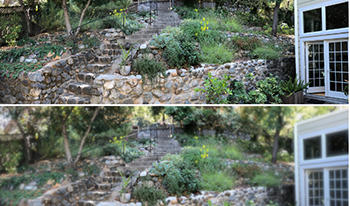
The Field of View (FoV), the Field of Resolution, and the Field of Contrast Sensitivity describe three progressively more detailed descriptions of human spatial sensitivity at angles relative to fixation. The FoV is the range of visual angles that can be sensed by an eye. The Field of Resolution describes the highest spatial frequency that can be sensed at each angle. The Field of Contrast Sensitivity describes contrast sensitivity at each spatial frequency, at each visual angle. These three concepts can be unified with the aid of the Pyramid of Visibility, a simplified model of contrast sensitivity as a function of spatial frequency, temporal frequency, and luminance or retinal illuminance. This unified model provides simple yet powerful observations about the Field of Contrast Sensitivity. I have fit this model to a number of published measurements of peripheral contrast sensitivity. This allows us to test the validity of the model, and to estimate its parameters. Although the model is a simplification, I believe it provides an invaluable guide in a range of applications in visual technology.

Augmented reality (AR) is growing in popularity, blending virtual objects into the real world, and one challenge it demands is the detailed colorimetric study. This research comprises two parts: a model of the displays in a commercial AR optical see-through head-mounted display (OST-HMD) was made using colorimetric measurements and spatial characterization, followed by a color matching experiment to explore the matching criteria when matching nonuniform colors in AR. The OST-HMD model was constructed by combining a traditional display model with camera-measured spatial luminance maps. Data from the color matching experiment were compared with the spatial model in order to infer the observers’ matching criteria when matching nonuniform patches. The experimental result suggests that the matching criterion is most likely position- or content-guided and measurably different from other possible criteria. The results can be used to improve uniformity in OST-HMDs and as a reference in modeling color appearance in AR.